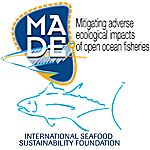A growing management tool aimed at increasing the worldwide sustainability of large-scale fisheries is the release of bycatch species. However, the effects of such fishing practices on the post-release survival of incidentally caught species is poorly understood. Historically, pelagic sharks have had a significant presence as bycatch in purse seine fisheries and this study seeks to better understand how sharks captured with commercial gear may experience a combination of physical trauma and large physiological perturbations that may affect their post-release survival. Sixteen satellite archival tags were deployed on purse-seine captured pelagic sharks (silky sharks, n=13; scalloped hammerheads, n=3) during 2011 and 2012 in the eastern Pacific Ocean. The tags monitored the post-release diving behavior (e.g., depth and temperature preferences) of sharks for 30 to 45 days. All hammerheads appear to not have survived post-release, despite showing little or not physical trauma and being considered strong while on deck. Two silky sharks, deemed strong on the deck, appeared to have not survived, six showed immediate post release mortality, two snagged sharks appeared to have survived and three more recent tags have not reported to date. Taken together, the post-release survival for all sharks ranged from 0% for hammerheads to 35% for silky sharks, with approximately 69% of all sharks not surviving the capture event. The low post-release survival of the pelagic sharks captured with a purse seine suggests that in order to minimize the potential impact on these incidentally captured species, all direct (physical) gear interactions may need to avoided.
- Presentation

 PDF version
PDF version
